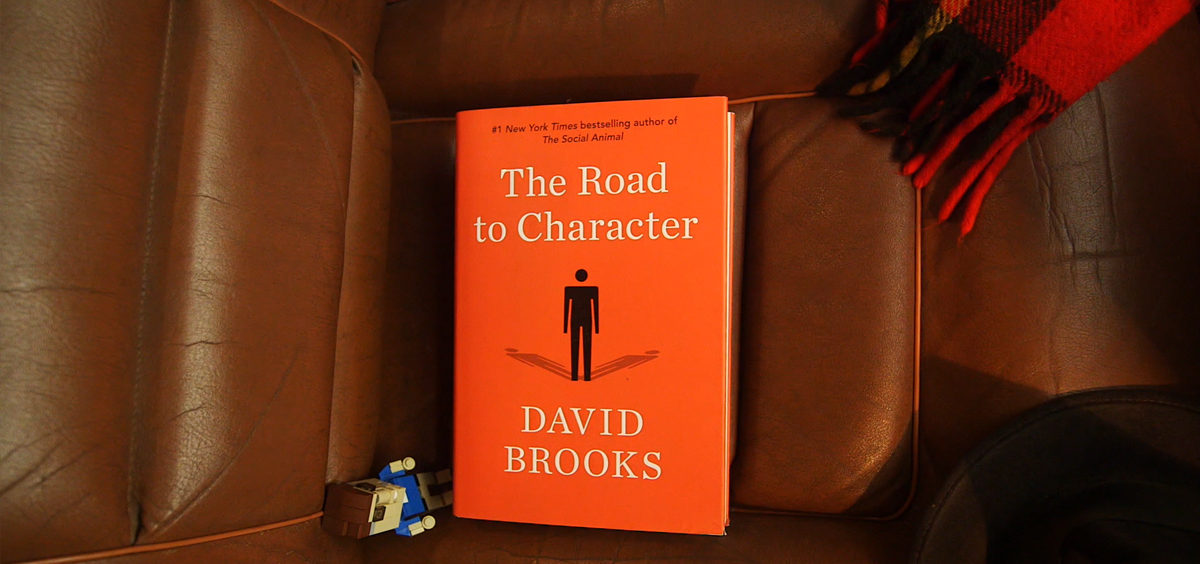I’m currently reading a book by David Brooks called The Road to Character. To me, reading has always felt like an exercise, akin to push-ups or—on the most challenging days—burpees. For those of you who don’t know (and you should feel lucky you don’t), the burpee combines the conditioning of your core, your legs, your arms, and your cardiovascular system. Picture a plank, not the standard thirty-second one but a single-second one, where you have kicked your legs behind you from a standing position. You jump your legs back forward and burst up from a squat, only to perform the same action fifteen-or-so times while wheezing and thinking about french fries. The reading equivalent is when I tried to read The Bible for pleasure.
The David Brooks book is easy to read, so you could compare it to a sit-up, but my taking in the content via Brooks’s matter-of-fact delivery has been fifteen burpees per chapter. It’s not that the content is dense like Descartes. It’s the emotional toll of questioning my character based on both researched fact and human examples that is leaving my muscles sore.
So what are all these hard-to-swallow bites of wisdom?
Brooks alludes to Lonely Man of Faith, a book written by Rabbi Joseph Soloveitchik (if you don’t feel like pronouncing his name in your head as you read this, just do as I did and change his name to “Solly”). Soloveitchik introduced the concepts of Adam I and Adam II. Brooks kindly set this analogy to modern day examples, assigning the label Adam I to the career-oriented, success-driven individual. Meanwhile he assigns the label Adam II to the individual who confronts their “sins” and works to better themselves in the privacy of their own mind. But these two people are actually both inside each of us.
According to Brooks, society used to adhere more to the Adam II persona; we used to refrain from advertising our accolades, wishing to be worshipped. When we won wars, we celebrated in the streets, but, when interviewed, we said, “I’m just glad it’s over.”
Think sporting events. Picture the touchdown dances, the ripping off of soccer jerseys. I’ve been playing sports since I was four. I recall an instance in middle school, when I played travel basketball, in which I fouled so many opponents that I “fouled out” of the game, meaning I essentially was ejected; it was not the first time, and it would not be the last. But, especially because the crowd (overzealous parents) were booing the referees, I turned to the side of the gymnasium where these fans were leaning against the wall and shaking their heads and their fists, and I bowed. It became my signature gesture. The whoops and claps I got fed my ego to the point where I spent my eighteen-year athletic career pointing and waving at spectators in softball games and slamming my stick against my goalie pads in field hockey games.
Recalling these displays of cockiness delivers a surge of mmph through my chest. I am an athlete—a good one! The crowd loves me; why shouldn’t I pump my fist and shimmy my shoulders? With the words of David Brooks pulling me in the opposite direction, my brain hurts. I question my morals, my humility. Can sports be exempt from this scrutiny? Please?
A few days ago, I attended a Yankee game with my parents. Between innings, the big screen would display reels of stand-out catches, hits, pitches, intermingled with footage of the players flashing number ones, popping their jerseys, and nodding at the camera—something out of a hip-hop music video. Would Brooks scoff at such displays of showmanship and swagger; would he be worried about contemporary culture? Does it matter? Yankee fanatics want to see their players perform well, to see them exude confidence and competence. Add a rap song and you have a stadium packed with amped-up sports fans. A passionate crowd motivates athletes, and motivated athletes play with more passion. Passion fuels performance. Who is harmed by this cycle?
Let’s talk about art. Art is often considered an expression of self, but is this expression of self skewed because an audience is involved? How can an artist be sure that they are painting, filming, writing, speaking from their true character when they know that people will absorb their content? I write, and about half my writing is public. Is this writing less honest than my journal entries? I’m spiraling into an identity crisis.
I’ve had some time to think about this, and here is my tentative conclusion:
My honest self is someone who shares. I choose to sacrifice fragments of my Adam II in order to connect with people. Socrates wants me to examine my life; does he have a problem if I do it openly? If so, he’s dead, so I why should I care?
Art is the middle ground, I’d like to think, between Adam I and Adam II. It sounds cheesy or pretentious; hear me out. You might subconsciously curate yourself, but most of what you’re curating is raw content. What’s the point in living on this planet with 7.6 billion other people if you’re not going to interact with them, from small talk to philosophizing? And this goes for “superficial” conversations—ones about makeup or crushes—though intellectuals like Brooks may look down on these topics.
If I had the authority to give advice to people who publicize their lives, I would suggest they continue to do so as long as it brings them joy and validation, but perhaps letting their followers get a whiff of their vulnerability would engage them with their Adam II, thus crushing feelings of falsehood. When delivered with a message, perhaps one’s self-image could be art.
